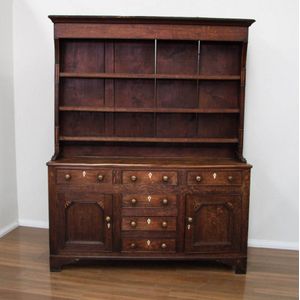George III Plate Rack Back Dresser with Patina
You must be a subscriber, and be logged in to view price and dealer details.
Subscribe Now to view actual auction price for this item
When you subscribe, you have the option of setting the currency in which to display prices to $Au, $US, $NZ or Stg.
- Bow Front - The front is shaped in a gentle curve or bow. Introduced during the 18th century, the bow-front is associated with furniture of the Hepplewhite and Sheraton period, though of course the form continued to be used throughout the 19th century. Bow-fronted pieces are usually veneered, although some were cut from the solid wood. Where veneer is used, the carcase is cut either from pine or deal, or sometimes the front was built up and shaped with small timber 'bricks'. Commonly used on various types of furniture including chairs, settees, chests, side tables, sideboards and display cabinets.
- Patination / Patina - In broad terms, patination refers to the exterior surface appearance of the timber, the effect of fading caused by exposure to sunlight and air over the course of a century or more, changing the piece to a soft, mellow colour.
As patina is very difficult to replicate, it is one of the most important guides to determining the age of furniture.
Patina is also the term applied to the bloom or film found on old bronzes due to oxidisation. - Bracket Feet - On bracket feet the corner edge is square and joined by a mitre to its partner on the opposite angle. The inner edge is usually shaped or scalloped. Bracket feet were first introduced in the early 18th century and used until c. 1830 and are found on carcase furniture such as chests, cabinets, bookcases and bureaux.
Ogee bracket feet, a variation on straight bracket feet, have the outside edge forming an "S" shaped curve with the top bulging outward and the bottom turning inward.
On splayed bracket feet, the exterior edge curves outward. - George Iii - George III (1738 - 1820) was King of Great Britain and Ireland from 1760 to 1820.
This item has been included into following indexes:
Visually similar items

An early 18th century oak and elm dresser with pierced scalloped cornice above open shelves, the base with six drawers, and enclosed cupboards; shaped feet. Width 161 cm

A fine Tasmanian bookcase, birdseye huon pine, circa 1835, full huon pine construction including backing boards, 241 cm high, 144 cm wide, 61 cm deep

A William IV mahogany bookcase cabinet, the two glazed doors of the bookcase with original glass, over a cabinet starting with two drawers above two doors with inset panels, 210 cm high, 178 cm wide, 48 cm deep

A George III 18th century oak Welsh dresser, the raised back with pediment and frieze, above three moulded shelves, the base with three frieze drawers, above three further drawers, flanked by panel door cupboards. 200 cm high, 162 cm wide, 45 cm deep.
